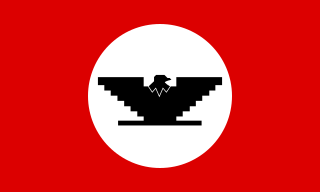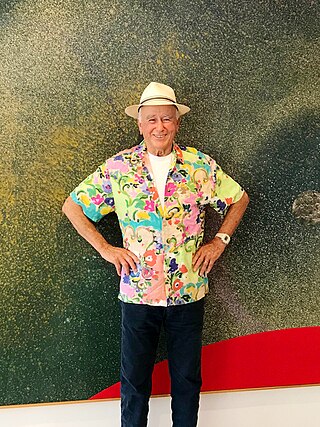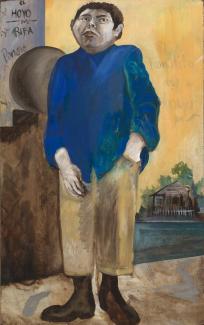
Hard-edge painting is painting in which abrupt transitions are found between color areas. Color areas often consist of one unvarying color. The Hard-edge painting style is related to Geometric abstraction, Op Art, Post-painterly Abstraction, and Color Field painting.

The Los Angeles County Museum of Art (LACMA) is an art museum located on Wilshire Boulevard in the Miracle Mile vicinity of Los Angeles. LACMA is on Museum Row, adjacent to the La Brea Tar Pits.
Edward Joseph Ruscha IV is an American artist associated with the pop art movement. He has worked in the media of painting, printmaking, drawing, photography, and film. He is also noted for creating several artist's books. Ruscha lives and works in Culver City, California.

Los Four was a Chicano artist collective active based in Los Angeles, California. The group was instrumental in bringing the Chicano art movement to the attention of the mainstream art world.

Mark Bradford is an American visual artist. Bradford was born, lives, and works in Los Angeles and studied at the California Institute of the Arts. Recognized for his collaged painting works, which have been shown internationally, his practice also encompasses video, print, and installation. Bradford was the U.S. representative for the 2017 Venice Biennale. He was included in Time Magazine’s list of the 100 Most Influential People in 2021.

Helen Lundeberg (1908–1999) was an American painter. Along with her husband Lorser Feitelson, she is credited with establishing the Post-Surrealist movement. Her artistic style changed over the course of her career, and has been described variously as Post-Surrealism, Hard-edge painting and Subjective Classicism.

Billy Al Bengston was an American visual artist and sculptor who lived and worked in Venice, California, and Honolulu, Hawaii. Bengston was probably best known for work he created that reflected California's "Kustom" car and motorcycle culture. He pioneered the use of sprayed layers of automobile lacquer in fine art and often used colors that were psychedelic and shapes that were mandala-like. ARTnews referred to Bengston as a "giant of Los Angeles's postwar art scene."

Stephen J. Powers is an American contemporary artist and muralist. He is also known by the name ESPO, and Steve Powers. He lives in New York City.
RISK, also known as RISKY, is a Los Angeles–based graffiti writer and contemporary artist often credited as a founder of the West Coast graffiti scene. In the 1980s, he was one of the first graffiti writers in Southern California to paint freight trains, and he pioneered writing on "heavens", or freeway overpasses. He took his graffiti into the gallery with the launch of the Third Rail series of art shows, and later created a line of graffiti-inspired clothing. In 2017, RISK was knighted by the Medici Family.
The Rosamund Felsen Gallery is one of the longest-running art galleries in Los Angeles, California, involved in and influencing the broader American art community since its establishment in 1978. The gallery has operated four locations since its inception: first on La Cienega Boulevard in Los Angeles, then on Santa Monica Boulevard in West Hollywood, later at Bergamot Station in Santa Monica, and finally in the Arts District, Los Angeles in Downtown Los Angeles.

John Wehrle is an American artist currently living in Richmond, California. Wehrle is best known as a muralist and site-specific installation artist, predominantly active in California. Proficient in painting, sculpture and photography, his work is in public and private collections. Several of his exterior mural works, Fall of Icarus, Positively Fourth Street, and Galileo Jupiter Apollo achieved underground iconic status during their existence. Wehrle's interior murals and surviving installations have been internationally collected.
J. Keith Wilson is an American Asian art curator. He is the Associate Director and curator of Ancient Chinese art at the Freer Gallery of Art and Arthur M. Sackler Gallery at the Smithsonian Institution in Washington, DC. Wilson is the former chief curator of Asian art at the Los Angeles County Museum of Art (LACMA).

Earl Alexander Powell III, nicknamed Rusty Powell, is an American art historian and museum director. From 1980 to 1992, he was Director of the Los Angeles County Museum of Art. He was appointed Director of the National Gallery of Art in Washington, D.C., in September 1992. The Gallery announced in November 2017 that Powell would step down in 2019. He was appointed to the U.S. Commission of Fine Arts in 2003 and elected Chair in 2005. He was appointed to a second four-year term on August 30, 2012, and continues to serve as Chair.

Suzanne Muchnic is an art writer who was a staff art reporter and art critic at the Los Angeles Times for 31 years. She has also written books on artists, collectors, and museums.
Elizabeth McCord was an American modernist painter whose colorful biomorphic and architectural abstractions influenced the hard-edge movement of the 1950s and were uniquely poised at the intersection of Southern California’s thriving mid-century art, design, and architecture scenes. Her work frequently appeared in shows at the Los Angeles County Museum of Art, the Long Beach Museum of Art, the Los Angeles Art Association, and the Art Center College of Design alongside works by Lorser Feitelson, Helen Lundeberg, Josef Albers, June Wayne, and Knud Merrild, among others.

Roberto Chavez is an American artist, known for his personally symbolic portraits, public murals and "funny-grotesque" paintings that reflect the multicultural landscape of Los Angeles. He was recently included in the Getty Center's Pacific Standard Time: Art in L.A., 1945-1980 and the Smithsonian’s Our America: The Latino Presence in American Art exhibits.
Pratapaditya Pal is an Indian scholar of Southeast Asian and Himalayan art and culture, specializing particularly in the history of art of India, Nepal and Tibet. He has served as a curator of South Asian art at several prominent US museums including Boston's Museum of Fine Arts, the Los Angeles County Museum of Art, and the Art Institute of Chicago, where he has organized more than 22 major exhibitions and helped build the museums' collection. He has also written over 60 books and catalogs, and over 250 articles on the subject, taught at several universities, and served as the editor of the Indian art magazine, Marg. In 2009 he was awarded Padma Shri by the Government of India for his contributions to the study of Indian art.

Norman Charles Zammitt was an American artist in Southern California who was at the leading edge of the Light and Space Movement, pioneering with his transparent sculptures in the early 1960s, followed in the 1970s by his large scale luminous color paintings.

Gloria Kisch (1941–2014) was an American artist and sculptor known especially for her early post-Minimalist paintings and wall sculptures, and her later large-scale work in metal.

RABI is a first generation American visual artist of Puerto Rican and Polish descent from Los Angeles, California. He is known for being part of the artist collective, CYRCLE. RABI's works can be seen in public and private collections including that of Shepard Fairey, Ari Emanuel, Sean Combs, Museo de Arte Contemporáneo de Puerto Rico, MOCA Detroit, Bishop Museum in Hawaii, MGM Grand in Las Vegas, The Art of Elysium, and the Contemporary Art Center in New Orleans.















